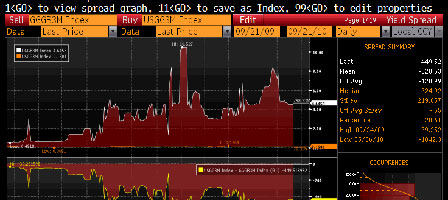Does that make the lowest-risk sovereign bonds a good investment at current prices? Yes, for a proportion of your holdings, especially if you are an investor whom by age, wealth or other personal circumstances requires a conservative portfolio. However, there is an alternative asset class with significant attraction – blue chips.
The Economist notes that in Europe yields on ten-year government bonds have fallen well below average dividend yields. “Even if dividends did turn out to be stagnant for the next decade” – as derivatives suggest the market expects to happen – “investors would still get a higher income from equities than from government bonds.”

If inflation does take off, dividends would rise whereas government bonds would look horribly overpriced. “The prospects for equities may not be great… but they may still be the best of a bad lot.”
But which equities?
For decades the best returns for equity investors have generally come from the shares of small and midsized companies. The heavyweights have underperformed.
Is that going to change in a low-growth global economy?
The case for high-quality defensive stocks
Some advisers whose views I respect are starting to argue that, especially if you’ve got enough high-risk commodity stocks and expensive Asian counters, and/or you’re nervous about bonds because of inflation risk, you should focus on blue chips – very large, well-managed corporations with global brands and a worldwide reach.
Jeremy Grantham, master strategist of US fund manager GMO, for example, is forecasting that over the next seven years high-quality American stocks are likely to return an average of 7.3 per cent a year, compared to just 1.1 per cent for the rest of the 500 largest listed firms. Patient investors should wait for opportunities to buy when shares fall to levels where they are “fair value,” he says.
Eoin Treacy at Fullermoney suggests that “companies with a global franchise offer an excellent avenue to the expansion of the global middle class which is driving world-beating economic growth in Asia and Latin America.”
Bill Miller, chief investment officer at Legg Mason Capital Management, says now is “a once-in-a-lifetime opportunity… to buy the best quality companies in the world at bargain prices. The last time they were this cheap relative to bonds was 1951.”
Rory Gillen of Ireland’s InvestR Centre is promoting the idea that US global consumer franchise stocks are “a decent port in a storm.”
They “offer the most basic of products or services, yet have unique attributes that investors often overlook. They offer defensiveness in their earnings, no financial risk (currently), mixed currency and emerging markets exposure and, following the decade-long bear market in equities, better value than they have in possibly two decades.”
The earnings yield available from a handful of such stocks is more than twice the yield on US government ten-year bonds, yet there is a “high probability” of future growth in their earnings.
“The repetitive nature of the demand for Coca Cola’s products in difficult as well as buoyant economic conditions, its bullet-proof brand, and global distribution power” provide its earnings with resilience.
“Likewise, McDonalds’ low price points, speed of service and consistency of product have allowed it to consistently dominate the fast food industry globally and to deliver reliable growth over time.
“Proctor & Gamble has a collection of multi-billion-dollar brands in household and personal care products where, again, demand is steady in good times and bad.”
There is clearly value in global consumer franchise stocks, whether or not there is a double-dip recession.
However, I am not convinced that earnings yield relative to bond yield is a reliable measure of comparative value. Earnings figures are often inflated by creative accounting. And as earnings are not distributed, except the portion paid out as dividends, they are not directly comparable with bond interest. They are more useful as a measure of how stable future payment of dividends is likely to be, and as a measure of past growth and value relative to other equities.
Another problem is that when researching this subject I was shocked to find how poor is the earnings growth record of most of the very large companies that we tend to think of as blue chips, and which stock-market advisers categorize as such. source and CopyRight OnTarget Newsletter by Martin Spring
read further – Some ideas for long-term, low-risk investing



